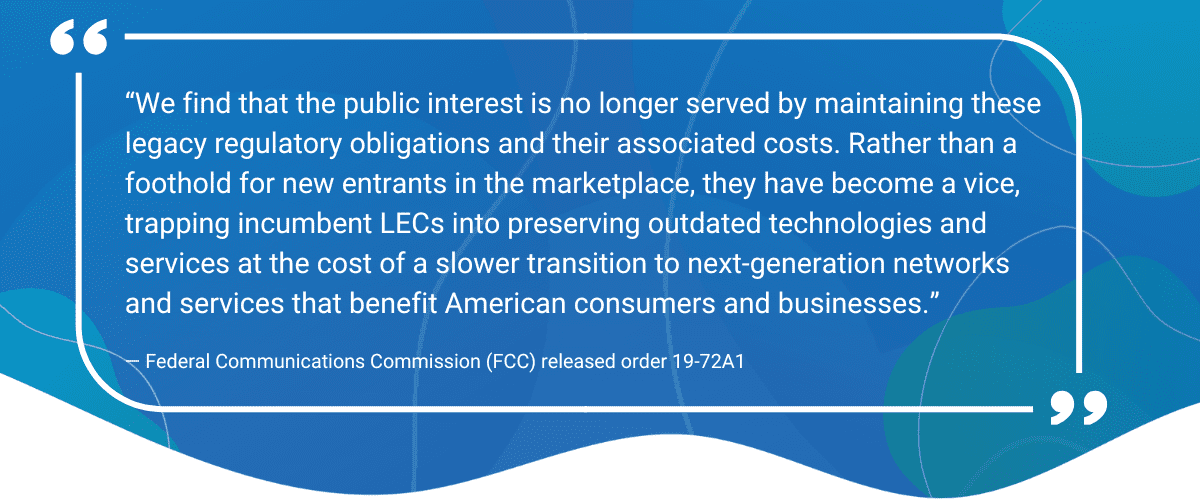Curious what the telecom trends are for 2023? The upcoming years are a unique opportunity for communication service providers (CSPs) to fundamentally reimagine their business or, alternatively, risk another decade of decline. Perhaps your business needs to reduce costs, expand revenue opportunities, or improve margins. Is this the time for a pivot — to reinvent your business model?
As 2023 looms, what is your organization focusing on? Some CSPs may even need to do all of these at once.
2023 Trend #1: The Death of Analog POTS Lines
Legacy POTS replacement is a forecasted 2023 trend, but it is not a tomorrow problem. In 2017, the Federal Communications Commission (FCC) told telecom providers to begin sunsetting their plain-old telephone system (POTS) lines, which has left communication service providers in the difficult position of either significantly increasing prices to maintain their legacy copper lines or selecting and deploying a modern cloud solution.
Have You Already Fallen Behind Your Competitors?

Earlier this year, AT&T announced its plan to decommission 50% of its legacy copper network by 2025, offering customers fiber-based services to replace legacy POTS.[i]

Verizon Business also sent a notice to its channel sales organizations that customers with a current VZB POTS lines must completely migrate, and those who didn’t migrate were subject to disconnection on or after April 30, 2022.[ii]

In April 2021, Windstream Enterprise publicized that “partners are facing business customers that want to upgrade from outdated technology and are clamoring for solutions to the rising cost of POTS and their lack of flexibility.”[iii]

Lumen launched a fully managed, POTS replacement solution April 2022. Scott Velting, Vice President of Product Management at Lumen said, “Our industry is challenged with a lot of legacy technology in the voice space, and our customers are looking for a solution that suits their needs, provides modernized technology, and sets them up for future growth opportunities.”[iv]
If multiple Tier 1 carriers are already in the process of migrating analog lines to digital, what’s holding up your business?
Sunsetting POTS Doesn’t Have to Be a Painful or Expensive
As service providers decide the best way to move forward, the data is clear that most will select a digital or cloud-based POTS replacement for flexibility, scalability, and low CAPEX.
As telco service providers decide the best way to move forward, the data is clear that most will select a digital or cloud-based POTS
replacement for flexibility, scalability, and low CAPEX. Look for a cloud communications provider with these best-in-class qualities:
Fully Managed. An end-to-end POTS replacement solution pays for itself. Consider the immense time required for in-house coordination with local jurisdictions and specialty vendors for site surveys, engineering, provisioning, technical support, hardware replacement, and more — just to get started! Seek a provider that handles that for you, so you can focus on your core business.
Decreased Latency. Unlike single box solutions that create an additional call processing step, multi-box devices are often fully modular with built-in redundancy, removable components, scalability, and the latest chip sets. When paired with dynamic cloud-based architecture, it supports high calls per second and little to no throttling (figure 1).
5G Connectivity. The quality of the customer premise equipment (CPE) can make or break your offering. If the selected devices already aren’t up to pace with market needs, imagine how immensely the technological gap will increase within the next 5–7 years (average time for hardware replacement). Competing against solutions that aren’t 5G capable will give your business a distinct advantage.
2023 Trend #2: Cost No Longer King, Innovation Is
In the constant and increasingly rapid evolution of the telecommunications landscape, there is no longer a simple tie between cost and known value. The true value of innovation for CSP is the infinite capacity for improvement and rapid rate of change, which are not captured or accurately measured by a traditional, simplistic, cost analysis.
As the need for legacy network transformation becomes more pressing for service providers, C-level telecom executives need to evaluate the decision not by the speed at which capital is recouped but also by its forward-looking impact.
Are You Driving Innovation Value—or Stagnating?
Emergent technologies behind cloud-based platforms transform not just your cost structure but your entire business. Like Maslow’s Hierarchy of Needs, service providers have basic needs that must be fulfilled first . . . but no one stops at level 1 or 2 by choice. Innovation — like Maslow’s self-actualization — doesn’t happen by accident. It’s a choice.
We forecast that CSPs that bring digital transformation to the forefront of their strategic priorities will grow revenue 8–10x faster (than CSPs that aren’t) in the upcoming years. Innovating is more complex than maintaining the status quo, and it’s infinitely more beneficial to your business, resulting in increased competitiveness in the market, product differentiation, expanding growth opportunities, and more.
Remaining 2023 Trends Impacting CSPs
In 2023, service providers need to digitally transform your network and accelerate growth or get left behind.
We looked at the trends in telecom over the past few years, which have been accelerated by the global COVID-19 pandemic, to give service providers guidance on how to meet their customers demand for digital services. Together, these strategic trends will guide you through driving factors of the future of the telecom industry and investment areas that should form the basis of revenue growth and cost optimization priorities for CSPs in 2023 and onwards.
Discover 2023 trends that impact communication service providers in our latest white paper.








